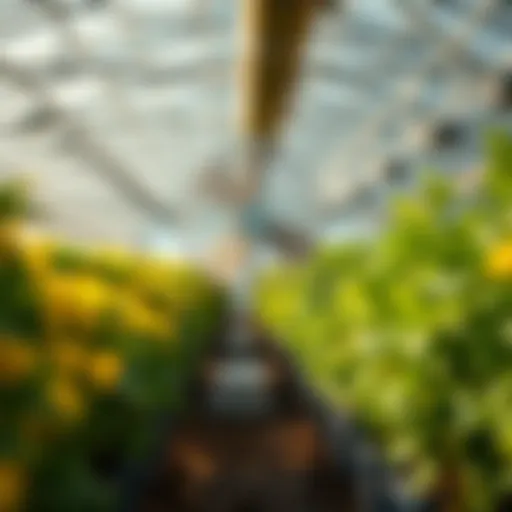Understanding the UN Sustainable Development Goals


Intro
The United Nations Sustainable Development Goals (SDGs) emerged as a critical framework guiding global efforts towards a more equitable and sustainable world. Adopted in 2015, these 17 goals represent a collective commitment by nations to address various societal and environmental issues by 2030. By outlining interconnected targets, the SDGs aim not only at alleviating poverty but also at fostering sustainable economic growth, improving health, and protecting the environment. As agriculture remains a vital sector for many communities worldwide, understanding how these goals impact farming practices becomes essential.
Key Concepts and Terminology
Definition of Terms
To engage effectively with the SDGs, it is essential to clarify some core terminology. Here are some key terms:
- Sustainable Development: Development that meets the needs of the present without compromising the ability of future generations to meet their own needs.
- Stakeholder Engagement: The process of involving all parties affected by a decision in the decision-making process.
- Interconnectedness: The way in which different goals and targets influence one another, emphasizing that progress in one area can lead to advancements in another.
Overview of Relevant Practices
Various practices align with the SDGs, particularly in agriculture. These practices include:
- Agroecological Farming: This involves applying ecological principles to agricultural systems, enhancing biodiversity and resource efficiency.
- Integrated Pest Management (IPM): A strategy that focuses on long-term prevention of pests through a combination of biological, cultural, physical, and chemical tools.
- Water Sustainability Efforts: Practices that promote efficient water use, recycling, and conservation in agricultural settings.
Current Trends and Innovations
Latest Research and Developments
Recent studies showcase a shift towards more sustainable agricultural methods aligned with the SDGs. Research highlights include:
- Vertical Farming: Utilizing advanced technologies to grow food in urban areas, minimizing land use and transportation emissions.
- Biotechnology: Developing crops that can withstand climate change impacts, enhancing food security.
Emerging Technologies and Tools
Innovations such as data analytics and IoT (Internet of Things) are transforming agriculture. These tools facilitate:
- Precision Agriculture: Using GPS and IoT to monitor crop health, optimize inputs, and increase yields.
- Blockchain: Enhancing supply chain transparency and assuring consumers of sustainable practices.
Practical Applications
Step-by-Step Guides
To align agricultural practices with the SDGs, consider the following steps:
- Assess Existing Practices: Evaluate current farming methods against SDG criteria.
- Engage Stakeholders: Involve local communities in discussions about sustainability.
- Implement Changes: Gradually adopt eco-friendly practices based on assessments and stakeholder feedback.
Troubleshooting Common Issues
Addressing challenges encountered in implementing the SDGs can involve:
- Lack of Resources: Collaborate with local governments or NGOs for support.
- Resistance to Change: Provide education on the benefits of sustainable practices.
The SDGs represent a path towards a holistic approach, balancing social welfare, economic growth, and environmental protection.
By comprehending the purpose of the UN SDGs, agriculture farmers can contribute to a sustainable future while enhancing their operations. Embracing these goals leads not just to compliance but also to innovation and improved resilience in the face of global challenges.
Foreword to the UN Sustainable Development Goals
The UN Sustainable Development Goals (SDGs) serve as a universal framework aimed at addressing the pressing issues confronting our world today. They articulate a vision for global development aligned with social needs, economic growth, and environmental sustainability. Understanding the SDGs is crucial for various stakeholders, including policymakers, corporations, and even individual citizens. The goals facilitate a clear and structured approach to sustainable development, urging all sectors to cooperate to achieve them.
The importance of the SDGs is further evident in their international recognition. These goals were adopted by all United Nations member states in 2015 as part of the 2030 Agenda for Sustainable Development. This universality means that all countries, both developed and developing, have distinct roles to play in fulfilling the SDGs. Hence, the commitment to these goals extends beyond mere compliance; it signifies a shared responsibility to transform lives and protect the planet.
Historical Context
The historical context of the Sustainable Development Goals can be traced back to the Millennium Development Goals (MDGs). Launched in 2000, the MDGs focused primarily on reducing extreme poverty and improving health outcomes. While some progress was made, numerous challenges persisted by 2015. The shortcomings of the MDGs highlighted the necessity for a more comprehensive approach to development, one that addresses environmental sustainability, social inclusion, and economic stability.
The formal transition from MDGs to SDGs reflects a shift in global priorities. The SDGs build upon the lessons learned from the MDGs, introducing a broader and more inclusive framework. They encompass issues such as climate change, sustainable cities, and equity, making them applicable to a wider audience and more relevant to modern challenges. The establishment of fourteen specific targets ensured that various issues are interconnected, recognizing the way these goals impact each other.
The Agenda for Sustainable Development
The 2030 Agenda for Sustainable Development is a transformative framework that aims to eradicate poverty in all its forms, tackle global inequalities, and ensure environmental sustainability. This agenda includes the 17 Sustainable Development Goals, along with 169 specific targets that provide a clear blueprint for action.
Each goal addresses a specific area of concern, ranging from poverty alleviation to environmental protection. One key aspect of the 2030 Agenda is its emphasis on leaving no one behind. This principle stresses the necessity of inclusivity and equity, ensuring that the most vulnerable populations are prioritized in development efforts. Each country is expected to adapt the global framework to its own national context while promoting participatory approaches that engage local communities.
The 2030 Agenda offers a holistic approach, recognizing the interdependence of social, economic, and environmental dimensions.


In summary, understanding the UN Sustainable Development Goals is essential for recognizing how collective action can lead to transformative changes globally. The historical context and the comprehensive nature of the 2030 Agenda highlight the evolving understanding of sustainable development and the critical role it plays in addressing the multifaceted issues facing society today.
Defining Sustainable Development
Sustainable development is a framework that embraces a holistic approach towards progress. It is essential in the context of the United Nations Sustainable Development Goals. This section aims to highlight why we need to define sustainable development clearly and its significance in compliance with these global objectives.
First, sustainable development integrates three core dimensions: economic growth, environmental protection, and social inclusion. These elements are not mutually exclusive; instead, they reinforce one another. A well-defined purpose of sustainable development is vital. It allows countries and organizations to plan effectively, ensuring that support is legitimized from various stakeholders. In this way, it becomes a guiding principle toward forming policies that address current issues while anticipating future challenges.
Conceptual Framework
The conceptual framework for sustainable development includes several key components that provide a structure within which practitioners operate. At its heart lies the idea that progress should be equitable and sustainable over time. For policymakers, this implies that economic activities must not only provide immediate benefits but must also consider long-term impacts on communities and ecosystems. This has considerable implications for agriculture, which needs to balance productivity with ecological integrity. When farmers consider sustainable practices, they potentially increase yields while reducing environmental harm.
Moreover, this framework encourages multi-disciplinary approaches. Collaboration across sectors—agriculture, economics, health, and education—fosters creativity and innovation. Sustainable development cannot exist in silos. By integrating diverse perspectives, solutions become more robust and adaptable to local contexts.
Key Principles of Sustainability
The principles of sustainability provide a roadmap for achieving the goals of the UN Sustainable Development Goals. Key among these is the principle of intergenerational equity. This suggests that the needs of the present must be met without compromising the ability of future generations to meet their own needs. In the realm of agriculture, this principle translates into practices that preserve soil health, conserve water, and promote biodiversity.
Another important principle is the emphasis on participation. Inclusion of various stakeholders—including farmers, local communities, and industry experts—ensures a diverse range of voices in the decision-making process. Thus, policies are more likely to be accepted and successful when they reflect the needs and priorities of those they affect. This makes a strong case for community engagement in agricultural practices, which can enhance sustainability.
Furthermore, a systems perspective is essential. Recognizing that agriculture operates within complex ecological and social systems requires understanding the interactions between various elements. This approach leads to a more holistic understanding of potential solutions and mitigates unintended consequences of interventions.
"Defining sustainable development is not just about preserving resources. It is about ensuring a thriving future for all, today and tomorrow."
In summary, sustainable development is a crucial concept for understanding and implementing the UN Sustainable Development Goals. It centers on balancing economic, environmental, and social factors, providing a framework for collaboration and active participation. The principles discussed play a significant role in guiding actions toward a sustainable future, especially within the agricultural sector.
Overview of the Sustainable Development Goals
The 17 Sustainable Development Goals (SDGs) form a comprehensive framework that seeks to address the urgent challenges facing our planet. Each goal is interconnected and designed to lead us towards a more sustainable future. Understanding these goals helps individuals and organizations navigate their contributions to global efforts.
These goals are not just broad aspirations. They represent specific targets that nations must aim to achieve by 2030. The simplicity of their language belies the complexities involved in their attainment. Overarching themes include poverty alleviation, environmental sustainability, and social equity. Here are essential aspects regarding the importance of the SDGs:
- Global Collaboration: The SDGs facilitate cooperation among countries. Nations engage in dialogues to share successful strategies and tackle difficulties at both local and global levels.
- Focus on People and Planet: They identify fundamental issues such as hunger, inequality, and climate change. They prioritize the well-being of marginalized communities, ensuring no one is left behind in the pursuit of sustainability.
- Holistic Approach: The goals emphasize a multifaceted strategy. They recognize that addressing one issue often impacts others. For example, improving education can lead to better health outcomes and reduced poverty.
Goal 1: No Poverty
Goal 1 aims to eradicate extreme poverty for all people everywhere. Currently, a significant portion of the global population lives on less than $1.90 a day, which highlights the need for immediate action to alleviate poverty levels. Addressing poverty involves improving economic growth, access to quality education, and providing social protection systems for vulnerable populations. Every action taken to enhance livelihood opportunities contributes to achieving this goal.
Goal 2: Zero Hunger
Zero Hunger focuses on ending hunger, achieving food security, improving nutrition, and promoting sustainable agriculture. Access to sufficient and nutritious food is essential for health. Emphasizing sustainable practices is particularly important for farmers to ensure continuous food supply. By promoting agricultural techniques that do not deplete resources, we work toward this essential goal.
Goal 3: Good Health and Well-Being
Goal 3 aims to ensure healthy lives and promote well-being for all at all ages. Significant health issues persist globally, including infectious diseases and maternal mortality. Universal health coverage and access to quality essential health services can alleviate these issues. Addressing health holistically is critical for sustainable development, as healthy populations contribute effectively to societies.
Goal 4: Quality Education
Education is a fundamental tool for breaking the cycle of poverty and promoting sustainable development. Goal 4 focuses on ensuring inclusive and equitable quality education. This goal emphasizes the importance of lifelong learning opportunities. When communities prioritize education, they foster innovation and economic growth.
Goal 5: Gender Equality
Achieving gender equality is crucial for sustainable development. Goal 5 aims to end discrimination against women and girls and ensures their full participation in public life. Empowering women leads to better economic growth and reduced poverty. Moreover, gender equality contributes to stronger institutions and peaceful societies.
Goal 6: Clean Water and Sanitation
Clean water and sanitation are vital for health and well-being. Goal 6 strives to ensure availability and sustainable management of water and sanitation for all. Access to safe drinking water boosts public health. Thus, enhancing infrastructure around water management practices is essential.
Goal 7: Affordable and Clean Energy
Goal 7 emphasizes the importance of affordable, reliable, sustainable, and modern energy for all. Energy is essential for economic stability and development. Transitioning to renewable energy sources can mitigate climate change effects and improve energy access.
Goal 8: Decent Work and Economic Growth
Sustained economic growth is necessary for a prosperous society. Goal 8 focuses on promoting inclusive and sustainable economic growth, employment, and decent work for all. Encouraging entrepreneurship can create job opportunities and improve living standards.
Goal 9: Industry, Innovation, and Infrastructure
Infrastructure is critical for economic development. Goal 9 aims to build resilient infrastructure, promote inclusive and sustainable industrialization, and foster innovation. A strong industrial base can benefit farmers through better supply chain management.


Goal 10: Reduced Inequality
Goal 10 addresses the need to reduce inequality within and among countries. Inequality poses a major barrier to sustainable development. Reducing disparities ensures more equitable access to resources, including education and healthcare, ultimately benefiting society as a whole.
Goal 11: Sustainable Cities and Communities
Urbanization presents both challenges and opportunities. Goal 11 focuses on making cities and human settlements inclusive, safe, resilient, and sustainable. Achieving this requires involvement from local governments and communities to improve urban planning.
Goal 12: Responsible Consumption and Production
The SDG Goal 12 highlights the need for sustainable consumption and production patterns. This goal underscores the need for efficient resource use. Businesses should invest in sustainable practices, reducing waste and enhancing recycling efforts.
Goal 13: Climate Action
Climate change is one of the most significant challenges we face today. Goal 13 urges for urgent action to combat climate change and its impacts. This includes integrating measures into national policies and enhancing education and awareness.
Goal 14: Life Below Water
Sustainable management of oceans is crucial. Goal 14 focuses on conserving and sustainably using the oceans, seas, and marine resources for sustainable development. Protecting aquatic ecosystems enhances food security, especially for nations that depend on fisheries.
Goal 15: Life on Land
Goal 15 aims to sustainably manage forests, combat desertification, and halt biodiversity loss. This is essential for maintaining ecosystems that provide vital resources. Healthy ecosystems underpin food security and improve resilience to climate change.
Goal 16: Peace, Justice, and Strong Institutions
Goal 16 emphasizes the need for peaceful and inclusive societies. Promoting the rule of law, ensuring equal access to justice, and building accountable institutions are key components. These elements create a foundation for sustainable societies.
Goal 17: Partnerships for the Goals
Lastly, Goal 17 calls for revitalizing global partnerships for sustainable development. Achieving the SDGs requires a collaborative effort from governments, the private sector, and civil society. Partnerships can help share resources and intelligence necessary for sustainable achievements.
"The Sustainable Development Goals are a shared blueprint for peace and prosperity for people and the planet, now and into the future."
In summary, the 17 Sustainable Development Goals provide a roadmap for a more equitable, sustainable, and prosperous future. Understanding each goal’s significance and interconnectivity encourages individuals, organizations, and countries to take collective action.
Interconnectivity of the Goals
The interconnectivity of the UN Sustainable Development Goals signifies a critical dimension in understanding their overall purpose and effectiveness. Each goal does not exist in isolation; rather, they are intricately linked, and progress in one area often influences outcomes in another. This means that an approach to facilitate sustainable development must recognize these connections. For instance, addressing climate action not only impacts environmental objectives but also plays a significant role in achieving goals related to poverty, health, and food security.
Recognizing these interconnections is essential for various reasons. First, it promotes a holistic approach to problem-solving. Agriculture, for example, can enhance health and nutrition, and simultaneously contribute to economic growth. To realize these connections, stakeholders must collaborate across sectors integrating multiple goals into cohesive strategies.
Second, understanding these links helps avoid siloed efforts that can undermine progress. When projects focus exclusively on one goal, they may neglect the broader implications. For example, focusing solely on economic growth without considering its environmental impacts can result in increased pollution and resource depletion, ultimately detracting from sustainable development.
Furthermore, recognizing interconnectivity fosters better resource allocation. When stakeholders account for multiple goals, they can prioritize initiatives that yield the highest returns across sectors. This leads to more effective use of limited resources, whether they be financial or natural.
In summary, the interconnectivity of the Sustainable Development Goals represents a framework where each goal enhances others. This perspective is vital for designing robust strategies that aim to capture the full spectrum of benefits derived from sustainable practices.
Mutual Reinforcement among Goals
The concept of mutual reinforcement among the Sustainable Development Goals encapsulates how outcomes of one goal can generate positive effects on others. For instance, investments in quality education (Goal 4) can lead to workforce empowerment, thus fostering decent work and economic growth (Goal 8). Similarly, quality education enhances gender equality (Goal 5) when engaging marginalized communities.
- Global Health and Economic Growth: Good health (Goal 3) is fundamental for productivity. A healthy population drives economic activity, underlining the mutual reinforcement among these sectors.
- Environmental Sustainability and Poverty Reduction: Clean water and sanitation (Goal 6) contribute directly to improved health outcomes and reduced poverty rates (Goal 1). Without clean water, communities struggle with illness, which in turn hampers economic progress.
- Innovation and Sustainable Industries: Investing in industry and infrastructure (Goal 9) also supports climate action (Goal 13) through green technologies. Innovative practices in sustainable farming can yield better crop productivity and resource management.
"The alignment of goals allows for a more efficient approach to sustainable development, transforming challenges into opportunities."
Through this mutual reinforcement lens, stakeholders can better grasp the implications of their actions, creating pathways that catalyze positive changes across multiple fronts. Each effort contributes to a wider benefit, demonstrating the necessity of strategic planning that factors in these intricate relationships.
The Role of Stakeholders in Achieving the Goals
The importance of stakeholders in achieving the UN Sustainable Development Goals (SDGs) cannot be overstated. These goals address complex global challenges that cannot be successfully tackled by any single entity alone. Diverse stakeholders play critical roles at various levels, from local communities to international organizations. Each stakeholder group brings unique perspectives and resources, making their involvement essential in creating sustainable solutions.
Stakeholder engagement ensures that the policies developed are inclusive and consider the diverse needs of different groups, particularly vulnerable populations who are disproportionately affected by issues like poverty, hunger, and climate change.
Governments and Policy Makers
Governments and policy makers are at the forefront of implementing the SDGs. They create the legislative frameworks and policies needed to drive progress toward these goals. Their role includes:
- Formulating Policies: Governments must integrate the SDGs into national strategies, ensuring that development plans prioritize sustainability. This includes allocating resources and funding to SDG-related projects.
- Creating a Regulatory Environment: Effective regulations can promote practices aligned with the SDGs. For example, enforcing laws related to environmental protection or labor rights can help meet specific goals.
- Monitoring and Reporting: Governments are responsible for collecting data and reporting on the progress of SDG implementation. Transparency in these efforts engenders accountability and can motivate other stakeholders to contribute.


"Without strong leadership from governments, the SDGs could remain mere aspirational goals, lacking the necessary action to produce meaningful change."
Private Sector and Industry
The private sector's contribution to achieving the SDGs is increasingly recognized. Businesses have resources, technologies, and innovations that can significantly advance sustainable development. Their involvement includes:
- Investing in Sustainable Practices: Companies need to adopt sustainable business models and practices. This often includes reducing waste, utilizing renewable energy, and considering social impacts in their operations.
- Partnerships for Innovation: Collaboration between businesses and other stakeholders can drive innovation. Technology developed in the private sector can solve sustainability challenges, for instance, improving efficiency in agriculture or waste management.
- Corporate Social Responsibility (CSR): Many companies engage in CSR initiatives that support local communities and align with SDG objectives. This not only enhances their brand image but also contributes positively to society.
Civil Society and Community Engagement
Civil society organizations, non-profits, and local communities hold a significant role in advancing the SDGs. They raise awareness, mobilize resources, and advocate for change on a grassroots level. Their contributions involve:
- Advocacy and Awareness: These organizations often work to inform the public about the SDGs and their importance. They mobilize support for initiatives that address local needs while aligning with broader goals.
- Engaging Communities: Grassroots involvement helps ensure that local voices are heard in the decision-making process. Empowering communities to participate in sustainable development initiatives fosters ownership and commitment to the goals.
- Monitoring Progress: Civil society can act as watchdogs, holding governments and businesses accountable for their commitments. They can provide valuable insights on the impact of policies and inform necessary adjustments.
Measurement and Evaluation of Progress
Measuring and evaluating progress towards the UN Sustainable Development Goals (SDGs) is crucial for understanding whether global initiatives are making a real impact. It allows for the assessment of ongoing efforts and identifies gaps that need addressing. Without effective measurement, policymakers cannot make informed decisions necessary to guide future developments.
Indicators and Metrics
Indicators are the backbone of the evaluation process. They provide quantifiable data that allows stakeholders to track progress. Various metrics are used to evaluate each of the 17 SDGs, reflecting the unique objectives of each goal. These indicators may include poverty rates, educational enrollment figures, water quality indices, and greenhouse gas emissions, among others.
For example, under Goal 1, which targets poverty eradication, an essential indicator might be the percentage of the population living below the national poverty line. Similarly, for Goal 2, focused on ending hunger, metrics like the prevalence of undernourishment in the population are critical.
Collecting consistent data is also a challenge. Different countries might use various definitions and methodologies, which complicate comparative analysis. However, the use of standardized indicators can help mitigate this issue, enhancing the reliability of the data.
Global Review Mechanisms
To ensure accountability and transparency, global review mechanisms are put in place. These include regular assessments by the United Nations that evaluate progress at an international level. The High-level Political Forum on Sustainable Development is a key element in this process. It provides a platform for countries to share their experiences and discuss progress and obstacles in implementing the SDGs.
Additionally, national platforms play a significant role. Countries need to prepare Voluntary National Reviews (VNRs) to report their progress. These reports help to inform global discussions and highlight the challenges faced at the national level.
Incorporating feedback from stakeholders such as NGOs, civil society, and academics enhances the credibility of these evaluations. Engaging these groups ensures that different perspectives are considered, which can lead to more tailored solutions that address specific local issues.
"Effective monitoring and evaluation are essential to track progress and make adjustments in real time to ensure success in achieving the goals."
The integration of technology can also facilitate measurement. Mobile data collection tools and satellite imagery can offer real-time data on several indicators. This technological advancement can help both in monitoring efforts and in enabling a quicker response to alarming trends.
In summary, the measurement and evaluation of progress towards the SDGs is not just administrative but acts as a strategic necessity. By grasping how well these goals are being met, we can better allocate resources and prioritize actions that align with genuine needs in diverse communities, particularly in agriculture. The success of SDGs ultimately hinges on robust measurement frameworks and global cooperation.
Challenges in Implementing the SDGs
The implementation of the United Nations Sustainable Development Goals presents various challenges that need careful consideration. Understanding these obstacles is crucial for improving strategies and making progress towards the desired outcomes. In this section, we will explore two primary areas of concern: political and economic barriers, and cultural and social obstacles. Addressing these challenges is essential for stakeholders, particularly in agriculture and related sectors, to navigate the complexities of achieving the SDGs.
Political and Economic Barriers
Political and economic barriers can significantly hinder the successful implementation of the SDGs. Governments must prioritize sustainable development in their policies. However, conflicting interests often arise. Decision-makers might focus on short-term gains, while the SDGs emphasize long-term benefits. This can create a gap between action and intention.
Budget constraints also play a major role. Many countries face economic challenges that limit their ability to allocate funds to sustainable initiatives. In agriculture, this could mean insufficient investment in technology and infrastructure. Without adequate resources, achieving goals like Zero Hunger or Climate Action becomes difficult.
Regulatory frameworks can also act as barriers. Inconsistent policies can create confusion for businesses and farmers. A clear, coherent policy direction is essential, yet many regions still operate with outdated systems that do not align with sustainable practices.
Cultural and Social Obstacles
Cultural and social obstacles present another layer of complexity in the implementation of the SDGs. Social attitudes towards sustainability can vary widely. In some communities, traditional practices may clash with new sustainable models. For instance, farmers might be resistant to adopting modern agricultural techniques that are more sustainable but require a shift from age-old practices. Overcoming this resistance is vital for progress.
Education plays a critical role here. A lack of awareness and understanding of sustainability impacts the adoption of new practices. Stakeholders must focus on educational programs that cultivate understanding at all levels of society. Engaging local communities can foster a sense of ownership, which is crucial in promoting sustainable practices.
Implementation also faces challenges from inequality. Marginalized groups often lack access to resources, information, and opportunities to contribute towards the SDGs. This reduces the effectiveness of initiatives that aim to include everyone. Therefore, addressing these inequalities must be central to any sustainable development strategy.
"Challenges in implementing the SDGs highlight the interconnectedness of political, economic, cultural, and social factors. They require a comprehensive approach to ensure all voices are heard and addressed."
In summary, political and economic barriers, along with cultural and social obstacles, must be tackled comprehensively if the SDGs are to be achieved. A unified effort from all stakeholders, including farmers, policymakers, and communities, is necessary for bridging these gaps.
Closures and Future Outlook
The Conclusions and Future Outlook section encapsulates the significant insights drawn from the analysis of the UN Sustainable Development Goals. This section emphasizes not only the achievements but also the ongoing challenges in sustainable development. It serves as a vital conclusion to the broader narrative, integrating the urgency of action with a hopeful perspective toward the future.
Understanding the effectiveness of the SDGs requires acknowledgment of innovations in technology and practices. This is essential, as agriculture and environmental sustainability face rapid changes in climate and resource availability. By utilizing cutting-edge technology, farmers can develop resilient crops, optimize water usage, and enhance soil health. The potential for biotechnology and precision agriculture can lead to greater yields while minimizing environmental impact. This is a crucial point, especially as food security becomes ever more critical.
Moreover, fostering a culture of collaboration among various stakeholders is a key future consideration. Institutions, governments, and individuals must work together to create comprehensive frameworks that support sustainable practices. Farmers are at the core of this shift, providing essential insights on the ground. Their knowledge about local ecosystems and agricultural conditions can guide policy and innovation.
"Engagement between stakeholders is vital, as shared knowledge fosters sustainable growth."
The ongoing dialogue around sustainable practices must also evolve. The interconnectivity of global challenges means solutions cannot be isolated to individual goals. Effective collaboration could entail workshops, joint ventures, and resource sharing that reduce redundancies and amplify results. This enhanced cooperation will not only benefit agriculture but also drive progress towards all 17 SDGs.
In summary, the pathway to achieving the Sustainable Development Goals lies in embracing innovations and fostering collaboration. These focus areas are instrumental in ensuring that the goals are not merely aspirational but rather attainable through actionable strategies that involve everyone.







